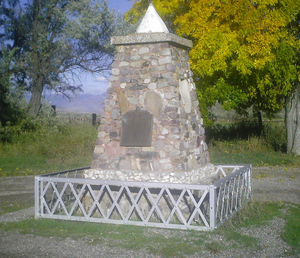Bear River Massacre
| Bear River Massacre | |||||||
|---|---|---|---|---|---|---|---|
| Part of the American Indian Wars, American Civil War | |||||||
 A monument erected by the Daughters of Utah Pioneers commemorating the event. |
|||||||
|
|||||||
| Belligerents | |||||||
|
|
Shoshone | ||||||
| Commanders and leaders | |||||||
|
|
Bear Hunter † | ||||||
| Strength | |||||||
| ~200 | ~300 +families | ||||||
| Casualties and losses | |||||||
| 67 total 21 killed 46 wounded |
410 total 246 killed 164 wounded or captured |
||||||
The Bear River Massacre, or the Battle of Bear River or Massacre at Boa Ogoi, took place in present-day Idaho on January 29, 1863.
After years of skirmishes and food raids on farms and ranches, the United States Army attacked a Shoshone encampment, gathered at the confluence of the Bear River and Beaver Creek in what was then southeastern Washington Territory. The site is located near the present-day city of Preston in Franklin County, Idaho. Colonel Patrick Edward Connor led a detachment of California Volunteers as part of the Bear River Expedition against Shoshone Chief Bear Hunter.
Hundreds of Shoshone men, women and children were killed near their lodges, while only two dozen soldiers died. The number of Shoshone victims reported by local settlers was higher than that reported by soldiers.
Cache Valley, originally called Seuhubeogoi (Shoshone for "Willow Valley"), was the traditional hunting ground for the Northwestern Shoshone. They gathered grain and grass seeds there, as well as fished for trout and hunted small game such as ground squirrel and woodchuck; and large game including buffalo, deer, and elk. This mountain valley had attracted fur trappers such as Jim Bridger and Jedediah Smith, who visited the region. Cache Valley was named for the trappers' practice of leaving stores of furs and goods (i.e., a cache) in the valley as a base for hunting in the surrounding mountain ranges.
...
Wikipedia
